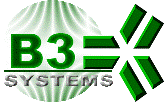
Contact Us
Phone: +1.919.790.9090
Fax: +1.919.790.0550
Address: 3208 Spottswood St., STE 106, Raleigh, NC 27615
Copyright © B3 Systems, Inc. 2025